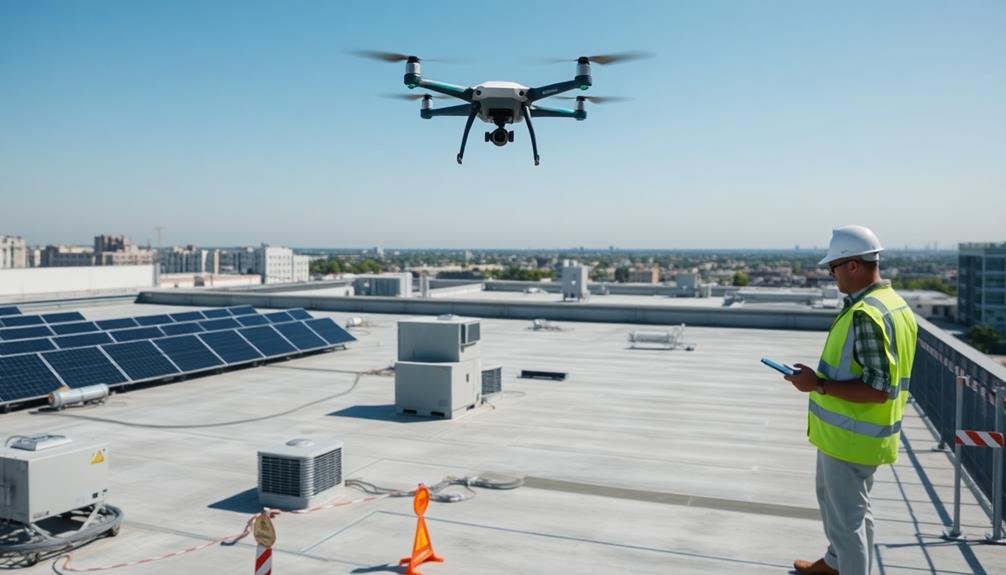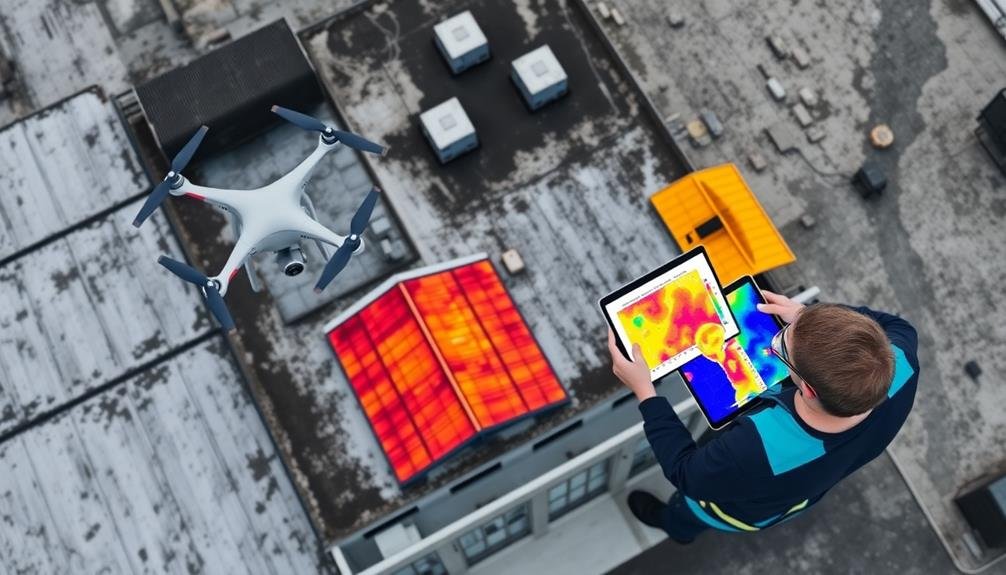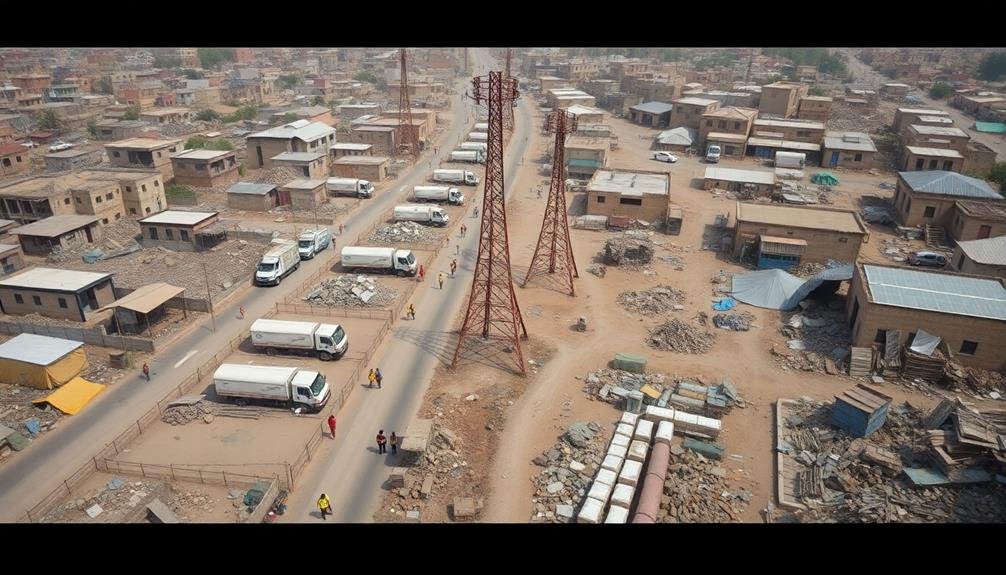To conduct industrial roof inspections with drones, you'll need to prepare thoroughly and choose the right equipment. Start by verifying your drone and camera, familiarizing yourself with the site, and checking weather conditions. Make sure you're compliant with FAA regulations and obtain necessary certifications. Plan your flight path, taking into account the roof's layout and potential hazards. During the inspection, maintain consistent altitude and speed while capturing high-resolution images. Afterward, analyze the collected data for signs of damage and create a detailed report with recommendations. By following these steps, you'll perform efficient and accurate drone-based roof inspections. The full process involves even more essential aspects to keep in mind.
Key Takeaways
- Verify proper equipment, familiarize with the site, and check weather conditions before conducting the inspection.
- Select a drone with high-resolution camera, sufficient flight time, and appropriate size for the industrial roof's complexity.
- Plan flight paths in advance, using automated patterns to ensure complete coverage of the roof surface.
- Execute the flight with consistent altitude and speed, capturing high-resolution images in a grid pattern.
- Analyze collected data for damage signs, create a detailed report, and provide prioritized recommendations for maintenance.
Benefits of Drone Roof Inspections

In the domain of industrial maintenance, drone roof inspections offer numerous advantages over traditional methods. You'll find that drones provide a safer alternative to manual inspections, eliminating the need for workers to climb onto potentially hazardous rooftops. This reduces the risk of accidents and injuries associated with working at heights.
Drone inspections are also more efficient and cost-effective. You can cover large areas quickly, capturing high-resolution images and videos of the entire roof surface. This detailed view allows you to identify issues that might be missed during a manual inspection. You'll save time and labor costs while gaining a more thorough understanding of your roof's condition.
Additionally, drones enable you to access hard-to-reach areas of complex industrial roofs. You can easily inspect sections that would be challenging or impossible to examine on foot.
The data collected by drones is also more accurate and consistent, as it's not subject to human error or fatigue. You'll have a digital record of your roof's condition, making it easier to track changes over time and plan maintenance activities. This data-driven approach helps you make informed decisions about repairs and replacements, ultimately extending the life of your industrial roof.
Preparing for the Inspection

Several key steps are vital when preparing for a drone roof inspection. First, you'll need to verify you have the proper equipment. This includes a high-quality drone with a good camera, spare batteries, and any necessary accessories. You should also have a tablet or smartphone to control the drone and view live footage.
Next, familiarize yourself with the building layout and any potential hazards. Review blueprints or satellite imagery to plan your flight path and identify areas of concern. Check local weather conditions and regulations to confirm it's safe and legal to fly.
Before the inspection, create a checklist of specific areas to examine, such as drainage systems, HVAC units, and known problem spots. You'll want to brief your team on the inspection goals and assign roles if needed.
It's essential to test your equipment before the actual inspection. Perform a pre-flight check of your drone and verify all systems are functioning correctly. Calibrate your camera settings for the best image quality in the expected lighting conditions.
Choosing the Right Drone Equipment

Selecting the appropriate drone equipment is essential for effective industrial roof inspections.
You'll need to take into account the camera and sensor options that best suit your inspection needs, as well as the drone's flight time capabilities to guarantee complete coverage.
Additionally, evaluate the drone's size and maneuverability to navigate complex roof structures and tight spaces.
Camera and Sensor Options
When it comes to choosing the right drone equipment for industrial roof inspections, camera and sensor options play an essential role.
You'll want to select a high-resolution camera, ideally with at least 12 megapixels, to capture detailed images of roof conditions. Look for drones equipped with 4K video capabilities to record thorough footage of potential issues.
Consider thermal imaging sensors to detect heat signatures that may indicate leaks or insulation problems. These sensors can help you identify hidden moisture and energy inefficiencies.
LiDAR (Light Detection and Ranging) sensors are valuable for creating accurate 3D models of roof structures, allowing for precise measurements and volumetric calculations.
Multispectral cameras can detect wavelengths invisible to the human eye, helping you identify vegetation growth or material degradation. For enhanced visibility in low-light conditions, opt for drones with adjustable aperture settings or night vision capabilities.
Don't forget about gimbal stabilization to guarantee smooth, shake-free footage during flight. Some drones offer interchangeable camera systems, allowing you to switch between different sensors based on specific inspection needs.
Flight Time Considerations
Flight time stands out as an essential factor in choosing the right drone for industrial roof inspections. You'll want a drone that can stay airborne long enough to complete your inspection without interruption.
Consider the size of the roof and the complexity of the inspection when determining the necessary flight time. Most consumer drones offer 20-30 minutes of flight time, while professional models can reach up to 45 minutes or more.
To maximize your drone's flight time and efficiency during inspections:
- Plan your flight path in advance
- Use automated flight patterns when possible
- Carry spare batteries for quick swaps
- Optimize your camera settings before takeoff
Remember that environmental factors like wind and temperature can impact battery life. In colder conditions, you may experience shorter flight times.
It's important to monitor your drone's battery levels throughout the inspection and plan for a safe return with ample power remaining. If you're inspecting large industrial roofs, consider investing in a drone with longer flight times or carrying multiple batteries to guarantee you can cover the entire area without compromising safety or data quality.
Drone Size and Maneuverability
The size and maneuverability of your drone play significant roles in its effectiveness for industrial roof inspections. When selecting a drone, consider the complexity of the roofs you'll be inspecting. Smaller drones offer greater agility, allowing you to navigate tight spaces and intricate roof structures. They're ideal for accessing hard-to-reach areas and maneuvering around obstacles like HVAC units or skylights.
However, larger drones often provide more stability in windy conditions and can carry heavier payloads, including high-resolution cameras or thermal imaging equipment. These features are vital for capturing detailed images and identifying potential issues on expansive industrial roofs.
Look for drones with obstacle avoidance systems and GPS positioning to enhance safety and precision during inspections. Foldable drones are a practical choice for easy transport between inspection sites.
Consider models with adjustable camera gimbals, allowing you to capture images from various angles without repositioning the entire drone.
Ultimately, you'll need to balance size, maneuverability, and payload capacity based on your specific inspection requirements. Test different drone sizes and configurations to determine which best suits your industrial roof inspection needs.
Safety Considerations and Regulations

When conducting industrial roof inspections with drones, you'll need to obtain proper certification as a drone pilot.
You must be aware of and comply with airspace restrictions in your area of operation.
Familiarize yourself with local, state, and federal regulations governing drone use for commercial purposes to guarantee legal and safe operations.
Drone Pilot Certification Requirements
Typically, operating drones for industrial roof inspections requires proper certification and adherence to safety regulations. In the United States, you'll need to obtain a Remote Pilot Certificate from the Federal Aviation Administration (FAA) under Part 107 rules. This certification demonstrates your understanding of drone operations, airspace regulations, and safety protocols.
To become a certified drone pilot for industrial inspections, you'll need to:
- Be at least 16 years old
- Pass an aeronautical knowledge test
- Undergo a TSA background check
- Register your drone with the FAA
Once certified, you must follow specific guidelines for commercial drone operations. These include flying below 400 feet, maintaining visual line of sight with your drone, and avoiding restricted airspace.
You'll also need to keep your drone registration current and renew your Remote Pilot Certificate every two years.
It's essential to stay updated on local and state regulations, as they may impose additional requirements or restrictions on drone usage for industrial inspections.
Airspace Restrictions Awareness
Understanding airspace restrictions is a key component of safe and legal drone operations for industrial roof inspections. Before flying, you'll need to check the airspace classification of your inspection site. Most industrial areas fall under Class G airspace, but some may be in controlled airspace near airports or other restricted zones.
Use the FAA's B4UFLY app or website to verify airspace status and any temporary flight restrictions. If you're operating in controlled airspace, you'll need to obtain LAANC (Low Altitude Authorization and Notification Capability) approval through the FAA's DroneZone portal or an approved UAS Service Supplier.
Be aware of no-fly zones around critical infrastructure, military installations, and national parks. Additionally, respect privacy concerns by avoiding flights over adjacent properties without permission.
During your inspection, maintain visual line of sight with your drone and stay below 400 feet AGL (Above Ground Level) unless you have a specific waiver. Always yield right of way to manned aircraft and never fly over people not directly involved in the operation.
Conducting the Aerial Inspection

Three key steps form the foundation of conducting an aerial inspection with drones.
First, plan your flight path carefully, considering the roof's layout and potential hazards.
Second, set up your drone's camera settings for peak image quality.
Third, execute the flight methodically, maintaining a consistent altitude and speed.
As you begin the inspection, focus on capturing high-resolution images of the entire roof surface.
Pay special attention to:
- Seams and joints
- Flashing and penetrations
- Drainage systems
- Areas of visible damage or wear
Fly in a grid pattern to guarantee complete coverage, overlapping each pass slightly.
Use both wide-angle shots for overall context and close-ups of specific areas of concern.
If your drone has thermal imaging capabilities, consider employing this feature to detect potential water infiltration or insulation issues.
During the flight, constantly monitor your drone's battery level and maintain visual line of sight.
Be prepared to abort the mission if weather conditions change suddenly or unexpected obstacles appear.
After completing the inspection, thoroughly review the collected data, marking areas that require further investigation or immediate attention.
This systematic approach will help you conduct a detailed and effective industrial roof inspection using drone technology.
Interpreting and Reporting Inspection Results

After completing the aerial inspection, you'll need to analyze the collected data to extract meaningful insights. Review the images and videos captured by the drone, looking for signs of damage, wear, or potential issues. Pay close attention to areas prone to problems, such as seams, flashing, and drainage systems.
Create a detailed report outlining your findings. Include a summary of the inspection process, key observations, and recommendations for repairs or maintenance. Use clear, concise language and support your conclusions with visual evidence from the drone footage.
| Common Roof Issues | Recommended Action |
|---|---|
| Ponding water | Improve drainage |
| Cracked membrane | Patch or replace |
| Loose flashing | Resecure or replace |
| Vegetation growth | Remove and treat |
| Debris accumulation | Clean and maintain |
Present your report to the client, explaining your findings and answering any questions they may have. Provide a prioritized list of recommended actions, considering factors such as urgency, cost, and potential consequences if left unaddressed. Offer guidance on preventive maintenance strategies to extend the roof's lifespan and improve its performance.
Frequently Asked Questions
How Often Should Industrial Roof Inspections Be Performed Using Drones?
You should conduct industrial roof inspections with drones at least annually. However, you'll want to increase frequency after severe weather events, for older roofs, or if you've noticed any issues. It's best to consult with roofing professionals for specific recommendations.
Can Drones Detect Specific Types of Roof Damage, Like Water Infiltration?
Yes, drones can detect water infiltration and other specific types of roof damage. They're equipped with thermal cameras that reveal temperature differences, indicating moisture. You'll also spot visual signs like blisters, cracks, or ponding through high-resolution imagery.
What Certifications Are Required for Drone Operators Conducting Industrial Roof Inspections?
You'll need a Part 107 FAA certification to fly drones commercially. For industrial roof inspections, consider additional certifications in thermography, building inspection, or roof assessment to enhance your expertise and credibility. Don't forget local licensing requirements.
How Do Weather Conditions Affect the Accuracy of Drone Roof Inspections?
Weather can greatly impact your drone roof inspections. You'll find strong winds affect stability, rain obscures visibility, and extreme temperatures can interfere with equipment. Bright sunlight may cause glare, while overcast conditions could reduce image quality.
Are Thermal Imaging Cameras Necessary for All Industrial Drone Roof Inspections?
Thermal imaging cameras aren't necessary for all industrial drone roof inspections, but they're highly beneficial. You'll find them essential for detecting moisture intrusion and energy loss. However, for basic structural assessments, standard cameras can suffice.
In Summary
You've now learned the essentials of industrial roof inspections using drones. By leveraging this technology, you'll save time, reduce risks, and gather detailed data. Remember to always prioritize safety, comply with regulations, and choose the right equipment for your needs. With practice, you'll become more efficient in conducting these aerial inspections and interpreting the results. Embrace this innovative approach to revolutionize your roof inspection processes and improve overall building maintenance.

As educators and advocates for responsible drone use, we’re committed to sharing our knowledge and expertise with aspiring aerial photographers.




Leave a Reply